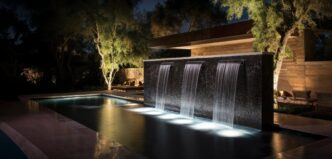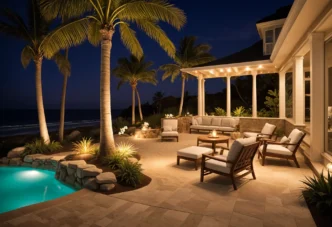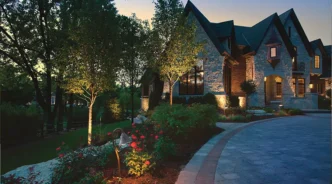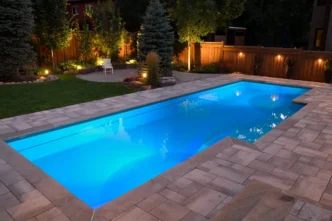Table of Contents
Biophilic Lighting Guide
Biophilic lighting is the answer to a common outdoor dilemma: too often, yards are lit with harsh, artificial fixtures that flatten the beauty of the landscape and leave the space feeling sterile. Instead of enhancing the connection to nature, traditional lighting can work against it. Biophilic lighting changes that.
Rooted in the principles of biophilic design, this approach to landscape lighting creates harmony between people, light, and the natural world—transforming outdoor areas into spaces that feel calming, energizing, and alive.
Let’s dive into what makes this form of landscape lighting so effective for yards like yours.
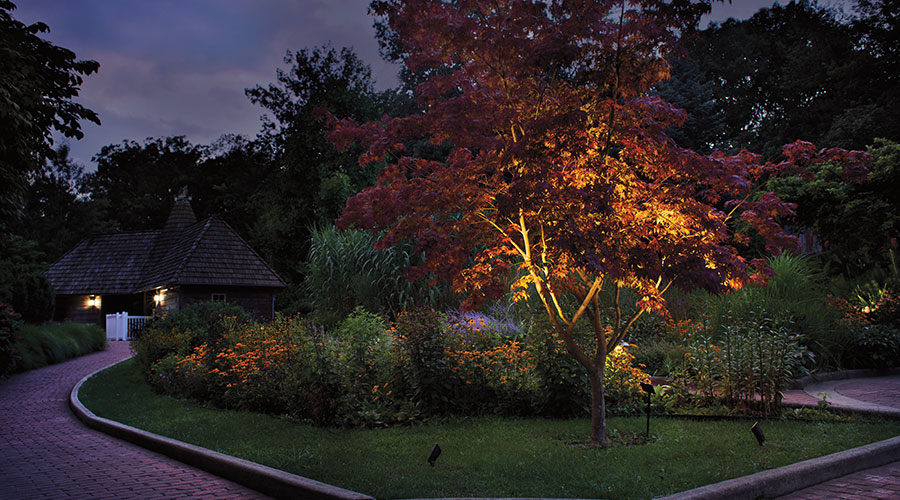
The Concept Behind Biophilic Lighting
Biophilic design is a growing movement in architecture and landscaping that aims to reconnect humans with the natural world. It recognizes that our wellbeing improves when we’re surrounded by elements that mimic or complement nature.
Biophilic lighting applies this concept to illumination. Rather than flooding a yard with harsh beams or overly artificial light, it uses thoughtful placement, warmth, and shadows to replicate the beauty of natural daylight and moonlight.
Key Features of Biophilic Lighting
Biophilic lighting is more than just brightness—it’s about balance. By echoing the warmth, movement, and patterns found in nature, it creates outdoor spaces that feel natural, inviting, and alive.
To truly capture the spirit of biophilic design, outdoor lighting systems use techniques that feel organic and life-giving:
- Natural Light Imitation: Choosing warm color temperatures (around 2700–3000K) that resemble firelight or sunset instead of stark white bulbs.
- Dynamic Patterns: Using fixtures that cast dappled light through leaves or across stone, echoing the movement of sunlight filtering through trees.
- Shadow Play: Highlighting depth and contrast instead of eliminating darkness, much like the natural balance of night and day.
- Integration with Nature: Installing fixtures discreetly so that the emphasis stays on trees, water features, and garden pathways rather than the hardware itself.
- Circadian Consideration: Aligning light levels and color tones with the body’s natural rhythms, supporting relaxation and healthier sleep cycles.
Benefits of Biophilic Lighting in Landscapes
Biophilic lighting transforms how you experience your yard after dark. Beyond beauty, it supports wellness, efficiency, and a deeper connection to the outdoors.
The advantages go far beyond aesthetics. Here’s why homeowners and designers are embracing this approach:
- Improved Wellbeing: Exposure to lighting that mimics natural patterns reduces stress, encourages relaxation, and promotes a stronger sense of place.
- Enhanced Beauty: Landscapes appear more vibrant, textured, and alive when illuminated in a way that honors their natural shapes and colors.
- Energy Efficiency: Many biophilic lighting designs rely on low-voltage LEDs and strategic placement, which use less electricity and minimize light pollution.
- Stronger Connection Outdoors: By making the night environment feel welcoming and natural, homeowners are encouraged to spend more time outside.
Designing with Biophilic Lighting in Mind
Incorporating biophilic principles into your outdoor lighting doesn’t have to be complicated.
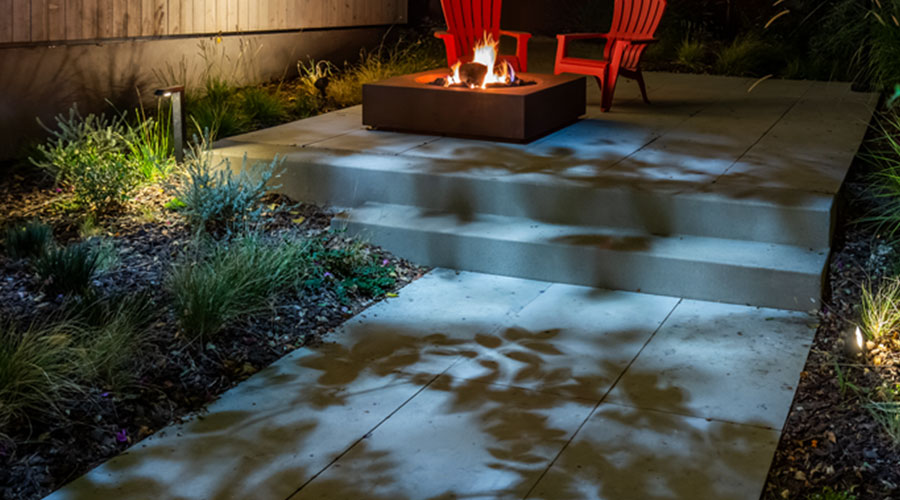
- Mimic Moonlight: Use downlights on trees to create the effect of soft moonbeams filtering through branches.
- Observe Natural Light: Study how sunlight and shadows move through your yard during the day. Notice where the sun rises and sets to guide your design.
- Guide with Subtlety: Install path lights that illuminate walkways gently, offering safety without harsh glare.
- Reflect and Sparkle: Add lighting around water features to capture shimmering reflections that feel organic and calming.
Transform Your Yard with Biophilic Lighting
Biophilic lighting isn’t just about seeing—it’s about feeling. By aligning outdoor illumination with the rhythms and aesthetics of nature, you create a space that supports wellbeing and enhances beauty, all while keeping the environment in mind.
It’s more than light on a timer; it’s light that feels alive.
FAQs for Biophilic Lighting
Biophilic lighting is a design approach that mimics the qualities of natural light to create healthier, more inviting spaces. It uses warm tones, dynamic shadows, and natural patterns to connect people with the outdoors even after sunset.
The six principles of biophilic lighting are natural light imitation, dynamic patterns, shadow play, circadian alignment, integration with surroundings, and energy efficiency. Together, they guide designers in creating lighting that feels both natural and restorative.
The 5-7 lighting rule recommends placing lights about 5 to 7 feet apart for pathways or garden areas. This spacing ensures safe, even illumination while preserving a natural rhythm that avoids over-lighting the landscape.
Join our Insider list and check out the different lighting options that we have to offer.
